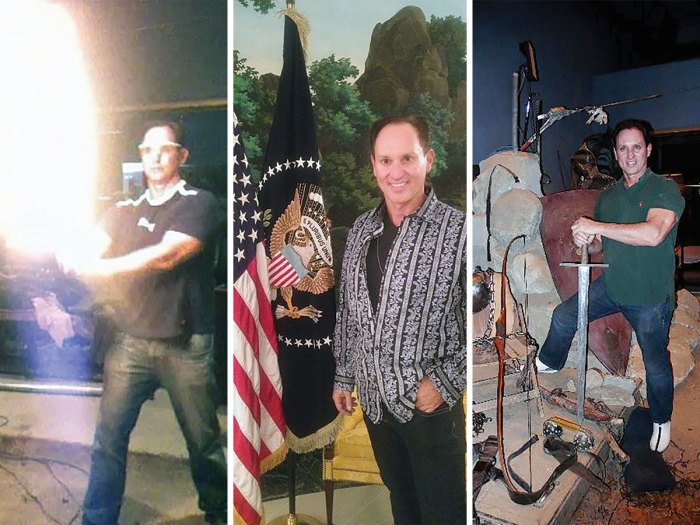Foley Artists Create the Sounds That Bring Movies to Life

The fight between good and evil is massive in scale — and extremely loud. Two opponents square off over a major city, exacting horrific damage in the process. Stone walls come crashing down. Streets are literally ripped apart. When the U.S. military shows up, the din grows even louder.
The fight is the climax of the 2013 movie Man of Steel. However, the multitude of sounds generated during Superman’s epic duel with General Zod were not recorded as the battle raged. Instead, they were created weeks later on a special soundstage by Foley artist Gary Hecker.
“The battle was huge because there was so much action,” the former Scout says.

Left to right: Hecker uses a fire torch to make sound effects for The Hunger Games’ flying fireballs; at the White House for a film conference; with the sword and other props used for Foley work in Robin Hood.
Hecker relied on a variety of props to create the sounds for Man of Steel. Hundreds of pounds of shaved ice, supplemented with bags of cat litter and cornstarch, helped create the sounds of Superman walking on snow. Layers of cloth, the sound of their movements electronically enhanced, provided the fluttering of Superman’s cape, which ranged from soft and gentle to bold and dynamic. And the sounds of Zod’s Kryptonian armor were achieved using fiberglass football pads along with medieval armor and other materials.
“Man of Steel was a very challenging movie,” Hecker says.
Storytelling Through Sound
Foley artistry is a Hollywood craft named after Jack Foley. He was a writer and performer who developed many of the tricks used to create the sound of movies when silent movies were replaced by “talkies” around 1927. Many of the tools and techniques Foley perfected are still in use today.
“Foley artistry is very important because it sets the tone for a movie by custom-designing the sound, whether it’s a period piece, a Western or a horror film,” Hecker says. “My job helps tell the story through sound.”
Hecker works on a Foley stage, which houses the props he most commonly uses to create sounds and the recording equipment to capture them. A cue sheet tells him the sounds required for every scene in a movie, such as a door opening or a sword being drawn.
As each scene plays on a screen in front of him, Hecker creates the individual sounds, which are blended together so they perfectly match the action. A cowboy riding a horse, for example, might require the sound of pounding hooves, a jingling bridle, slapping reins and other effects.
Tricks and Tools of the Trade
Hecker begins every project by recording the footsteps of the lead characters, followed by background footsteps. Footsteps might sound easy, but they involve much more than just walking around a microphone.
“Footsteps have to capture the essence of the character,” Hecker says. “If it’s someone like Arnold Schwarzenegger, for example, the footsteps have to sound big and beefy and strong.”
The tools of Hecker’s trade are varied and sometimes unusual. He uses celery for breaking bones and an old wooden chair to create a creaking door or timber on a ship. Hoofbeats are achieved with a patented device that mimics the sound of horses galloping. Hecker uses real swords to get the metallic sound of blades being drawn.

It took Hecker eight weeks to perform the “very challenging” Foley work for Godzilla, including creating the monster’s “voice.”
Sometimes Hecker even uses his own voice to add a unique element to a particular sound. For The Hunger Games, he combined a vocal whooshing noise with the sound of a fire torch to simulate fireballs racing by. Hecker also is known for creating unusual monster “voices,” including Godzilla, the aliens in Independence Day and the dragon in Shrek.
“Sounds can be difficult to come up with and hard to figure out,” he notes. “The guy who records me helps a lot because he uses his audio equipment to enhance the sounds I create. He can make something sound really big or really small.”
An Accomplished Pro
Hecker began apprenticing with established Foley artists when he was 17. One of the first movies he worked on was The Empire Strikes Back. For the past 17 years, Hecker has been working for Sony Pictures Entertainment as the supervising Foley artist.

Scenes from other movies Hecker has worked on: Pacific Rim and Shrek.
Hecker has done sound effects for more than 300 movies, including three Spider-Man movies, The Hunger Games, Pacific Rim and Jack the Giant Slayer. He also creates sound effects for videogames. Along the way, Hecker has received nearly 30 Golden Reel nominations from the Motion Picture Sound Editors and has won seven times. In 1998, Entertainment Weekly named him one of the 100 Most Creative People in Entertainment.
In 2013, Hecker was one of seven Hollywood professionals invited to the White House by Michelle Obama for a meeting aimed at young people interested in filmmaking. He brought along some of his props and demonstrated his craft in the president’s private theater.
“It was cool being able to inspire young people that way,” he says.
The Wow Factor
Hecker usually works with a movie’s sound supervisor, but occasionally he works with its director.
“Some directors are picky and put a lot of pressure on you,” he says, “but most are pretty cool. They are used to seeing their movies without sound effects, so when they finally see them with sounds added, they’re like, ‘Wow!’”
One fact that often surprises people is how grueling Foley artistry can be.
“It wears on you,” Hecker says. “This kind of work can be very physically demanding on your arms, legs and joints.”
But that doesn’t stop him from loving his job: “It’s a lot of hard work, but it’s also a lot of fun. When I see how the sounds I have created bring a movie to life, that makes me feel very good.”
JOB FACTS: FOLEY ARTIST
WHAT TO EXPECT: Foley artists provide all the sound effects in motion pictures and television shows. They also sometimes provide sound effects for videogames.
JOB OUTLOOK: Foley artists are an integral part of motion picture production, but only a handful of companies provide such services, so job opportunities are limited. Many Foley artists begin in TV and work their way up to feature films.
EDUCATION: Those interested in the profession are encouraged to attend film school to learn about sound recording and editing, and to approach sound service companies for apprenticeship opportunities.
SALARY: $45-$55/hour to start, according to the Motion Picture Editors Guild. However, rates may increase with experience.
FOR MORE INFO:
• What Is Foley Sound?
• The Art of Foley – What Is It?
That’s realy cool 👍😄
AWESOME!!!!!!!